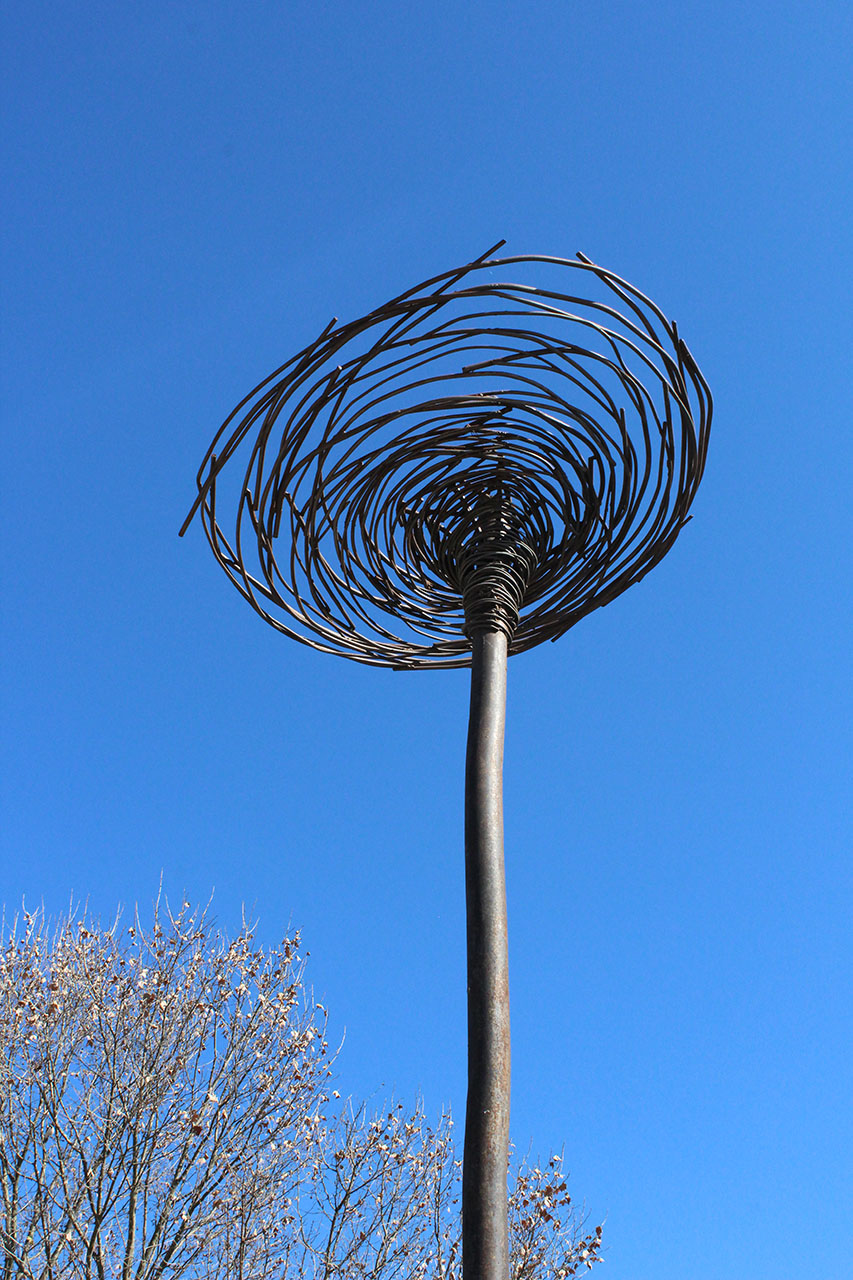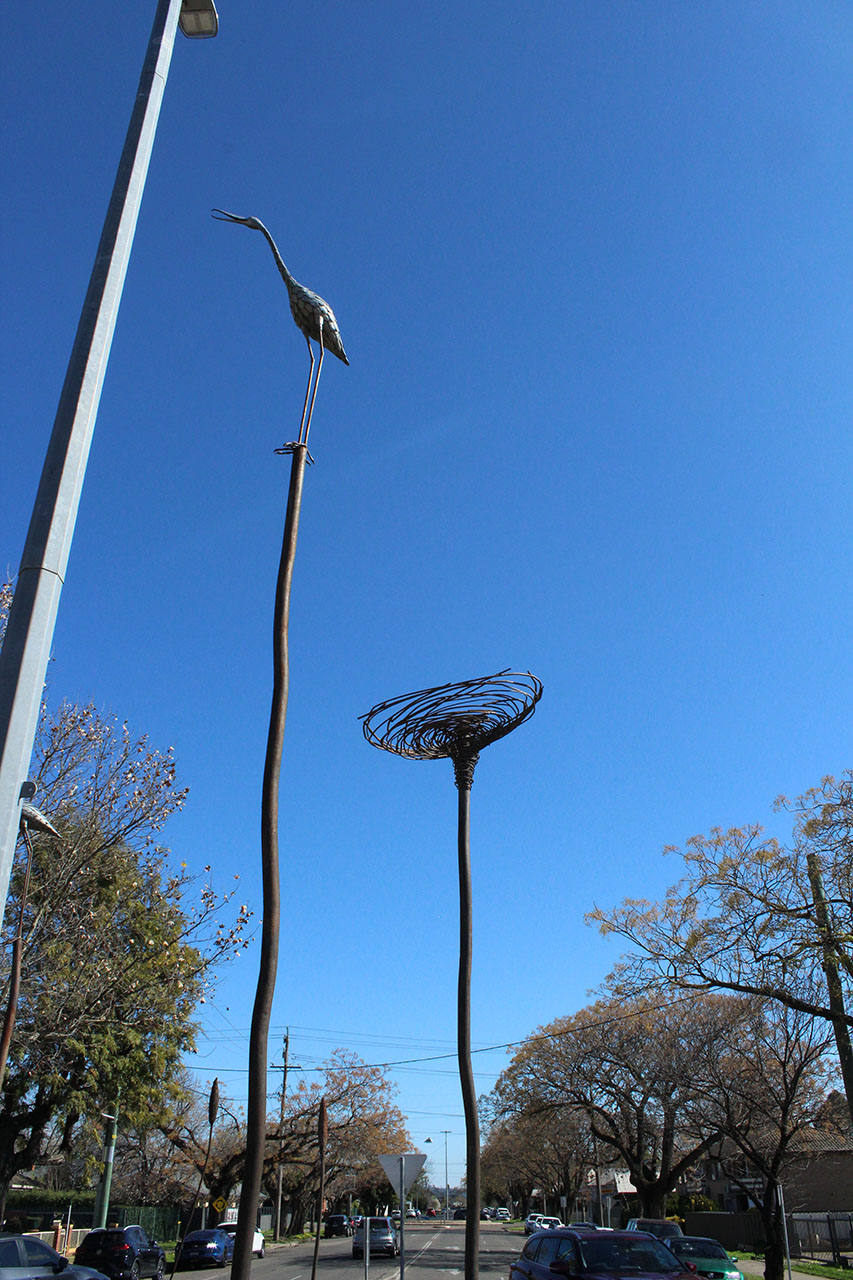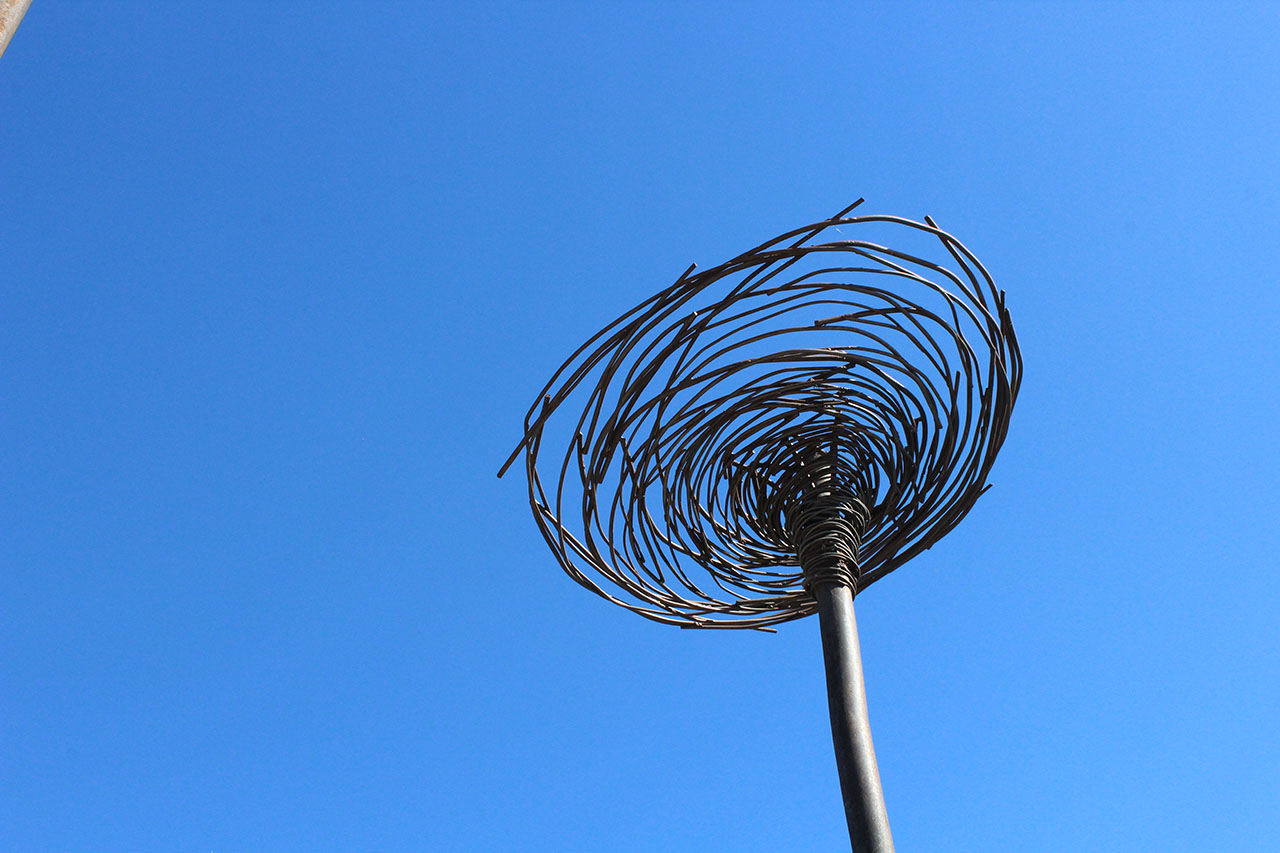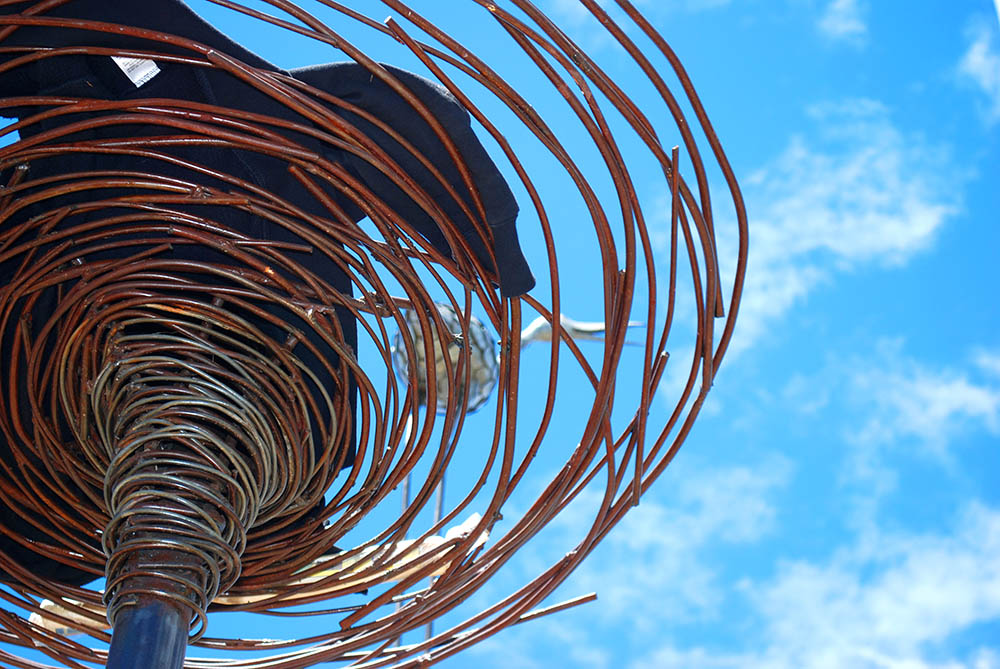Mild steel
Forsyth and Peter Street roundabout, Wagga Wagga
Public Art Audio Trail
Episode 11: Egret in flight, Grass Trees with Cranes, Empty Nest
Episode 11 combines Egret in Flight, Grass Trees with Cranes & Empty Nest.
Acknowledgement spoken by Bernard Higgins.
Narration, content and interview by Ashleigh Adams.
Sound and music by Sam Webber Sound.
Episode 11: Egret in flight, Grass Trees with Cranes, Empty Nest
Light piano music plays under narrator speaking
Behind Baylis Street, the Peter and Morgan Street and Peter and Forsyth Street roundabouts are home to two impressive sculptures by the late Michael Murphy. Murphy was a local artist commissioned in 1998 by Wagga Wagga City Council to create sculptures for the Peter Street roundabouts. He sadly passed away in 1999. Artist Zane Separovich assisted with the completion of the work ‘Egret in Flight’.
The Egret swooshes around the central streetlight of the Peter and Morgan Street roundabout. Its wings cut through the sky, leaving a contrail that forms the shape of a question mark. The bird represents the local young people, spreading their wings and leaving Wagga Wagga for larger cities. The question mark is Murphy’s way of asking why they continue to leave town.
Continuing to the Peter and Forsyth Street roundabout, we see a group of cranes exchanging squawks. They sit perched on thin poles that map five key sites of the city of Wagga Wagga: one faces the rising sun, another the hospital, then the university, the civic centre and Willans Hill. Five cranes were installed but only four cranes remain. The shortest crane was stolen in the years following Murphy’s passing. Local artist Casey Ankers created the work titled Empty Nest that sits perched in its place, with hopes that one day, the crane may return home.
Let’s hear from Dr Kirstin Davieswho was the Manager, Cultural Services at Wagga Wagga City Council when these two works were installed. She is going to tell us about the significance of these works and the impact that Michael Murphy’s public artworks continue to have on the community.
Music fades.
Narrator: Egret in Flight was so seamlessly integrated into the flow of the roundabout with that central pillar being the key anchor for the work, what can you tell me about the logistics of designing and installing a work that is suspended in the sky like that?
Kristin: It was quite a challenge actually this work from all sorts of perspectives, Michael had this vision that the tail of the egret would form a big question mark and from an engineering perspective that was extraordinarily difficult to achieve in a balanced way, so we had very funny meetings with structural engineers who were trying to figure out how to suspend this sculpture and still keep the integrity of the work. With Michael sort of I literally was sitting in between, Michael on one side and the engineers trying to arbitrate as they came to a compromise, which eventually they did. I think that Michael was probably a bit disappointed that it wasn’t as big of a question mark as obvious a question mark it ended up being. But we reached a comprise. It was certainly a challenge for the engineers. The central pillars actually was the existing light structure, and so the work had to be suspended from the existing structure, so we had obvioulsy had to get permission from the RTA which was also quite a long drawn-out difficult process, but they did approve it and it's great that it's there and remained for all of this time.
Narrator: Can you tell us about the way in which these works exemplify what Michael Murphy set out to achieve in his art?
Kristin: I think his art reflects his connection to the Riverina and his connection to the community, particularly the local environment of the Riverina, so I certainly think that was a key objective of his art that's why for example the Egret in Flight was asking the question as to why so many young people leave the region, because the birds positioned to face toward Sydney in particular. The other thing when I was thinking about Michael, I would describe him as rather worldly. He had many great artists similar to Michael in that they have a completely different perspective on the world and their local environment, and I think Micheal’s art brings that to us, his other worldly dimension of who he was as a person. His legacy is asking questions and linking nature with the local community of the Riverina.
Narrator: Michael Murphy was an incredibly talented sculptor and these works have continued to resonate with the community long after they were installed. What is it about his work that captivates audiences?
Kristin: I think it’s their connection to the local people and place that's particularly captivating. I mean he just made beautiful work too, so the beauty of his work is something certainly audiences have enjoyed now for a very long time, and I guess they've stood the test of time, I no longer live in Wagga unfortunately, but I know when I was there, they very deeply loved art works. In fact, when we were installing the five cranes piece Michael was there supervising it and a woman, a resident came up to him and said “are you the person that created my birds”, she called them my birds and he said “yes” and she gave him the biggest hug and she said thank you, thank you, so much. It's wonderful he got to experience the joy in a small way.
Narrator: Do you have any memories of working with Michael Murphy that you would like to share?
Kristin: Yes, I have many, many happy memories of working with Michael. He was an absolute perfectionist, which sometimes could be frustrating but at the same time I really admired his determination for excellence. We spent a lot of time together sort of nutting out how is sculptures would work um originally, I was, he came to my art classes which I used to teach in Wagga and he started working in metal at the time, but I could remember we had a life model one day and instead of drawing this beautiful model I looked at his drawing sheep in a yard, because he was thinking about that. I think I mentioned before he was rather worldly, he just had a different view on the world and that’s what made him such a great artist and an interesting person to know and to work with. I was always full of admiration for him and very glad I had the opportunity to work with him and to see that the legacy of his work continues to this day.
Light piano music plays again through to the end.
Narrator: Michael Murphy's love of birdlife was prominent throughout his body of work. Capturing birds in their moments of flight, take-off and landing required incredible technical skill. Although they are made of metal the egret in flight and grass trees with cranes have a sense of movement, a key characteristic of Michael Murphy’s sculptures.
The CBD of Wagga Wagga has a lot to offer with many places to eat, shop and drink as well as more artworks from the Wagga Wagga City Council public art collection. As you explore there are more episodes to be found on Baylis Street, around the Wollundry Lagoon and along the Wiradyuri trail up to Fitzmaurice Street. Please enjoy discovering the collection that celebrates Wagga Wagga and brings our public spaces to life.
Visual Description
Egret in flight:
Egret in Flight is a large-scale metal sculpture suspended by wires above the centre of a roundabout. The egret sores above the treetops. It is silver coloured and has a long neck with a small head and a pointed beak. Its great wingspan extends out on either side of its narrow body and its long thin legs trail along behind it as it flies. Large metal feathers cover the birds' wings. Flowing out from its wing feathers are 10 long metal lines that show the flight path of the bird leading up to the moment it has been depicted in. The Egret is flying around the central pillar on a tilted angle, its neck is angled upwards so that its head sits proudly observing the landscape out towards the horizon.
Below the egret on the roundabout is a low green-hedged garden. The sculpture can be viewed from the corners of the intersection. Depending on which corner it is viewed from you may see the underside of the bird or you may see its outstretched neck and wings tilted towards you.
Grass trees with cranes:
Grass trees with cranes is an installation in the centre of a roundabout. It consists of four metal cranes standing on tall thin metal poles of varying heights ranging from 3-6m high. The metal birds are cranes. They have thin, rod-like legs, oval shaped bodies, long necks, small heads and pointed beaks. The cranes are each shown in different poses. Some have their legs bent as if they are crouching low, and others are standing tall with their neck extended looking out across the landscape. They all have their beaks open about 45 degrees like they are talking to each other. There is a fifth metal pole with a large wire nest perched on top. On the ground on the base around the base of the metal poles are seven aquatic reeds made out of rusted metal. They have low floppy leaves and one tall stem that extends up from the centre of the plant. The plant stems are also of varying heights up to one and a half metres tall.
Explore the Trail
This artwork is a part of the Public Art Audio Trail, follow the link below to see all the artworks on the trail.
About the Artwork
The sculptures in the Peter and Morgan Street and the Peter and Forsyth Street roundabouts are the works of the late Wagga Wagga artist Michael Murphy. Created between 1998 and 1999 the works reflect the local flora, fauna and environment. The sculptures are constructed of mild steel.
In the years after Michael Murphy’s passing, one of the cranes from Grass Trees & Cranes was stolen. Casey Ankers, a local artist and friend of Michael Murphy, was commissioned to create this organic shaped steel nest to sit atop the empty steel post.




